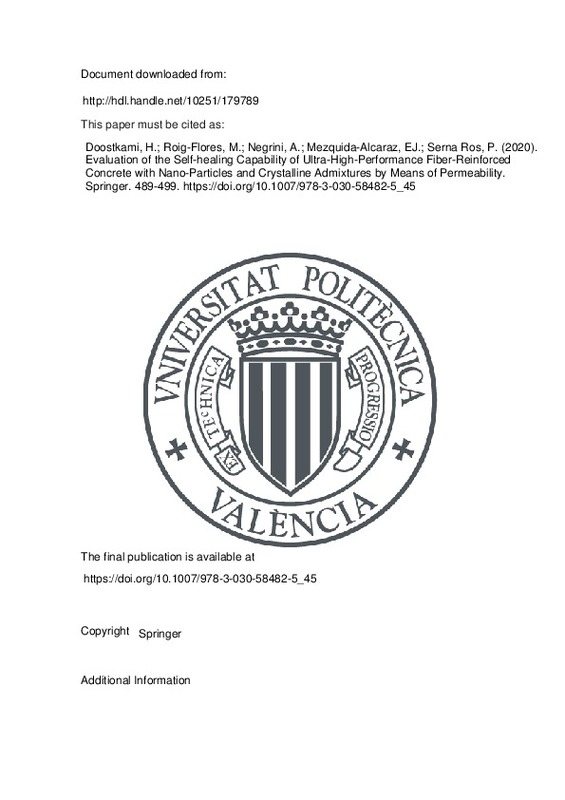Homma, D., Mihashi, H., Nishiwaki, T.: Self-healing capability of fibre reinforced cementitious composites. J. Adv. Concr. Technol. 7(2), 217–228 (2009)
Maes, M., Snoeck, D., De Belie, N.: Chloride penetration in cracked mortar and the influence of autogenous crack healing. Constr. Build. Mater. 115, 114–124 (2016)
Edvardsen, C.: Water Permeability and Autogenous Healing of Cracks in Concrete, vol. 96 (1999)
[+]
Homma, D., Mihashi, H., Nishiwaki, T.: Self-healing capability of fibre reinforced cementitious composites. J. Adv. Concr. Technol. 7(2), 217–228 (2009)
Maes, M., Snoeck, D., De Belie, N.: Chloride penetration in cracked mortar and the influence of autogenous crack healing. Constr. Build. Mater. 115, 114–124 (2016)
Edvardsen, C.: Water Permeability and Autogenous Healing of Cracks in Concrete, vol. 96 (1999)
De Belie, N., et al.: A review of self-healing concrete for damage management of structures. Adv. Mater. Interfaces 5(17) (2018)
Wang, H.L., Dai, J.G., Sun, X.Y., Zhang, X.L.: Characteristics of concrete cracks and their influence on chloride penetration. Constr. Build. Mater. 107, 216–225 (2016)
Wang, K., Jansen, D.C., Shah, S.P., Karr, A.F.: Permeability study of cracked concrete. Cem. Concr. Res. (1997)
Šavija, B., Schlangen, E.: Autogeneous healing and chloride ingress in cracked concrete. Heron 61(1), 15–32 (2016)
Ismail, M., Toumi, A., François, R., Gagné, R.: Effect of crack opening on the local diffusion of chloride in cracked mortar samples. Cem. Concr. Res. 38(8–9), 1106–1111 (2008)
Habel, K., Gauvreau, P.: Response of ultra-high performance fiber reinforced concrete (UHPFRC) to impact and static loading. Cem. Concr. Compos. 30(10), 938–946 (2008)
Denarié, E., Brühwiler, E.: Strain-hardening ultra-high performance fibre reinforced concrete: deformability versus strength optimization. Restor. Build. Monum. 17(6), 397–410 (2014)
Granger, S., Pijaudier-Cabot, G., Loukili, A.: Mechanical behavior of self-healed ultra high performance concrete: from experimental evidence to modeling. In: Proceedings of the 6th International Conference on Fracture Mechanics of Concrete and Concrete Structures, vol. 3, pp. 1827–1834 (2007)
Escoffres, P., Desmettre, C., Charron, J.P.: Effect of a crystalline admixture on the self-healing capability of high-performance fiber reinforced concretes in service conditions. Constr. Build. Mater. 173, 763–774 (2018)
Sisomphon, K., Copuroglu, O., Koenders, E.A.B.: Self-healing of surface cracks in mortars with expansive additive and crystalline additive. Cem. Concr. Compos. 34(4), 566–574 (2012)
Roig-Flores, M., Moscato, S., Serna, P., Ferrara, L.: Self-healing capability of concrete with crystalline admixtures in different environments. Constr. Build. Mater. 86, 1–11 (2015)
Roig-Flores, M., Pirritano, F., Serna, P., Ferrara, L.: Effect of crystalline admixtures on the self-healing capability of early-age concrete studied by means of permeability and crack closing tests. Constr. Build. Mater. 114, 447–457 (2016)
Ferrara, L., Krelani, V., Carsana, M.: A ‘fracture testing’ based approach to assess crack healing of concrete with and without crystalline admixtures. Constr. Build. Mater. 68, 535–551 (2014)
Ferrara, L., Krelani, V., Moretti, F.: On the use of crystalline admixtures in cement based construction materials: from porosity reducers to promoters of self healing. Smart Mater. Struct. 25(8), 1–17 (2016)
Cuenca, E., Cislaghi, G., Puricelli, M., Ferrara, L.: Influence of self-healing stimulated via crystalline admixtures on chloride penetration. In: America Concrete Institute, vol. 2018(SP 326), pp. 1–10. ACI Spec. Publ. (2018)
Borg, R.P., Cuenca, E., Gastaldo Brac, E.M., Ferrara, L.: Crack sealing capacity in chloride-rich environments of mortars containing different cement substitutes and crystalline admixtures. J. Sustain. Cem. Mater. 7(3), 141–159 (2018)
López, J.Á., Serna, P., Navarro-Gregori, J., Camacho, E.: An inverse analysis method based on deflection to curvature transformation to determine the tensile properties of UHPFRC. Mater. Struct. 48(11), 3703–3718 (2014). https://doi.org/10.1617/s11527-014-0434-0
López, J.Á.: Characterisation of the Tensile Behaviour of UHPFRC By Means of Four-Point Bending Tests, March 2017
Negrini, A., Roig-Flores, M., Mezquida-Alcaraz, E.J., Ferrara, L., Serna, P.: Effect of crack pattern on the self-healing capability in traditional, HPC and UHPFRC concretes measured by water and chloride permeability. In: MATEC Web Conference, vol. 289, p. 01006 (2019)
[-]







![[Cerrado]](/themes/UPV/images/candado.png)


